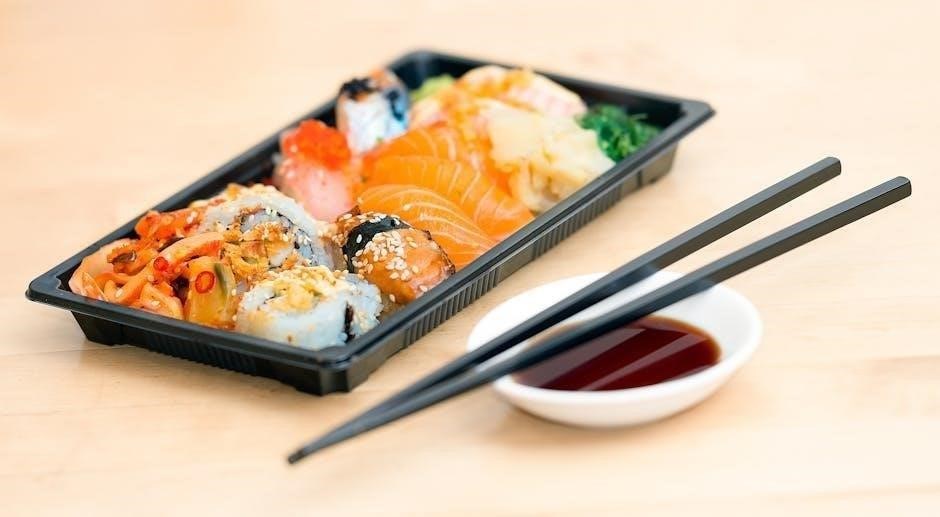Cooking Calrose rice with a rice cooker ensures perfect texture and flavor․ This medium-grain rice thrives in rice cookers, offering consistent results with minimal effort․ Grace Elkus, a culinary expert, highlights the convenience and reliability of this hands-off method, ideal for home cooks seeking fluffy, tender grains every time․
Overview of Calrose Rice
Calrose rice is a medium-grain variety known for its versatility and mild flavor․ Originating in California, it is widely used in Asian and fusion cuisines due to its soft yet firm texture․ This rice is ideal for dishes like sushi, stir-fries, and curries, as it holds together well without becoming mushy․ Its neutral taste makes it a great base for absorbing flavors․ Calrose rice is a staple in many households and restaurants, offering consistent results when cooked properly, especially in rice cookers․
Benefits of Using a Rice Cooker for Calrose Rice
Using a rice cooker for Calrose rice ensures perfect texture and flavor with minimal effort․ It automates the cooking process, maintaining the ideal water ratio and temperature․ This hands-off method prevents burning or sogginess, delivering fluffy, tender grains consistently․ Rice cookers are especially useful for busy home cooks, as they allow for unattended cooking․ The even heat distribution and precise timing make it easier to achieve professional-quality results․ This convenience makes rice cookers a valuable tool for preparing Calrose rice to its full potential․
Understanding Calrose Rice
Calrose rice is a medium-grain variety, popular for its mild flavor and sticky texture․ Originating in California, it’s widely used in Asian cuisine and beyond․
Origin and Characteristics of Calrose Rice
Calrose rice, developed in California during the 1940s, is a medium-grain rice variety known for its mild flavor and soft, slightly sticky texture․ Its versatility makes it a favorite in Asian cuisine and beyond․
Calrose rice is prized for its ability to hold together without being overly sticky, making it ideal for sushi, stir-fries, and everyday meals․ Its balanced flavor and texture ensure it pairs well with a wide range of dishes․
Texture and Flavor Profile
Calrose rice has a soft, slightly sticky texture with a mild, neutral flavor, making it versatile for various dishes․ Its medium-grain structure allows it to hold together well without being overly clingy․
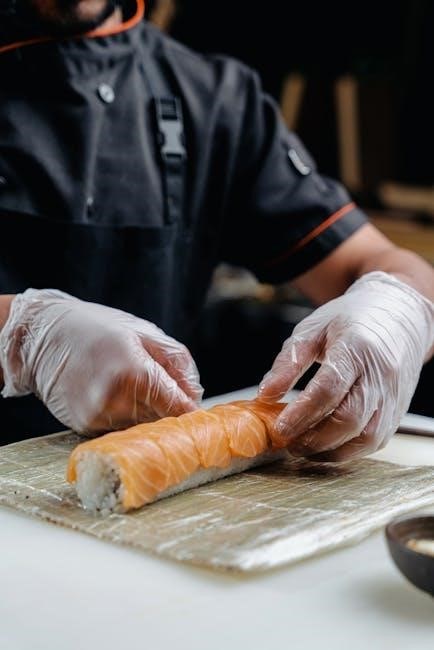
The subtle sweetness and creamy undertones enhance its adaptability in both Asian and international cuisines, from sushi to curries, ensuring a balanced and satisfying taste in every bite․
Popular Uses of Calrose Rice in Cuisine
Calrose rice is a versatile staple in many cuisines, excelling in dishes like stir-fries, curries, and sushi․ Its mild flavor and soft texture make it ideal for absorbing flavors in casseroles and as a side dish․
It’s also a favorite in fried rice recipes and pairs well with both savory and sweet elements, making it a adaptable base for a wide range of international and fusion dishes․
Preparing for Cooking
Measuring rice and water accurately ensures optimal results․ Rinsing Calrose rice removes excess starch, promoting even cooking․ Optional seasonings or add-ins can enhance flavor and texture․
Measuring the Right Amount of Rice and Water
Accurate measurement is key to perfect Calrose rice․ Generally, use a 1:1․2 ratio of rice to water․ For example, 1 cup of rice requires 1․2 cups of water․ Adjust based on desired consistency—slightly less for firmer grains or more for softer texture; Using a rice cooker simplifies this process, as it automatically manages water levels․ Ensure the measuring cup provided with the cooker is used for precise quantities․ This step ensures fluffy, well-cooked rice without excess moisture, making it ideal for various dishes․
Rinsing Calrose Rice Before Cooking
Rinsing Calrose rice before cooking is essential to remove excess starch and impurities, ensuring a fluffier texture․ Rinse the rice under cold water for about 30 seconds until the water runs clear․ This step prevents the rice from becoming sticky or clumpy during cooking․ Grace Elkus, a culinary expert, recommends this practice for optimal results․ After rinsing, drain well and proceed to cook in the rice cooker․ Proper rinsing enhances the natural flavor and texture of Calrose rice, making it ideal for various dishes․

Optional Seasonings and Add-ins
Enhance the flavor of Calrose rice by adding optional seasonings and ingredients․ Common additions include soy sauce, sesame oil, garlic, or ginger for a savory twist․ Herbs like bay leaves or thyme can add aromatic depth․ For extra richness, mix in diced vegetables, green onions, or toasted sesame seeds before cooking․ These additions infuse the rice with vibrant flavors, making it a versatile base for various dishes․ Experiment with different combinations to create unique taste profiles that complement your meals perfectly․
Cooking Process in a Rice Cooker
Cooking Calrose rice in a rice cooker is efficient and effortless․ This method ensures perfectly cooked grains with minimal supervision, ideal for home cooks seeking consistent results․
Step-by-Step Instructions for Cooking Calrose Rice
Rinse Calrose rice thoroughly under cold water to remove excess starch․ Add 1 cup of rice to the cooker with 1․2 cups of water․ Optional: add salt or oil for flavor․ Turn on the rice cooker and select the white rice setting․ Allow the cooker to complete its cycle, which typically takes 15-20 minutes․ Once done, let the rice rest for 5 minutes before fluffing with a fork․ This ensures fluffy, separate grains․ Grace Elkus recommends this method for consistent, hassle-free results every time․
Setting the Rice Cooker for Optimal Results
Select the “white rice” or “regular” setting on your rice cooker for Calrose rice․ Use a 1:1․2 ratio of rice to water for fluffy grains․ Add rice and water, then optional salt or oil․ Close the lid and start the cooker․ The cooking cycle typically takes 15-20 minutes․ Once complete, let the rice rest for 5 minutes to steam evenly․ This ensures tender, well-cooked grains․ Grace Elkus recommends this method for consistent, hassle-free results every time, making it ideal for home cooks․
Understanding the Cooking Cycle
The cooking cycle in a rice cooker involves heating, boiling, and simmering phases․ It starts with heating the water and rice, transitioning to a boil, then simmering to cook the grains evenly․ Once the water is absorbed, the cooker switches to a “keep warm” mode․ This cycle ensures Calrose rice cooks perfectly without constant monitoring․ Grace Elkus notes that this automated process delivers consistent results, making it ideal for home cooks․ The cooker’s sensors detect when rice is done, ensuring optimal texture and flavor every time, with minimal effort required․
Post-Cooking Care: Fluffing and Resting
After cooking, allow the rice to rest undisturbed for 5-10 minutes․ This lets steam distribute evenly, ensuring fluffy grains․ Gently fluff the rice with a rice paddle or fork to separate the grains․ Grace Elkus recommends this step to prevent clumping and achieve a light texture․ Avoid over-fluffing, as it can make the rice sticky․ Proper resting and fluffing enhance the texture and flavor, making Calrose rice ideal for various dishes․ This simple care ensures your rice remains tender and perfectly cooked every time․
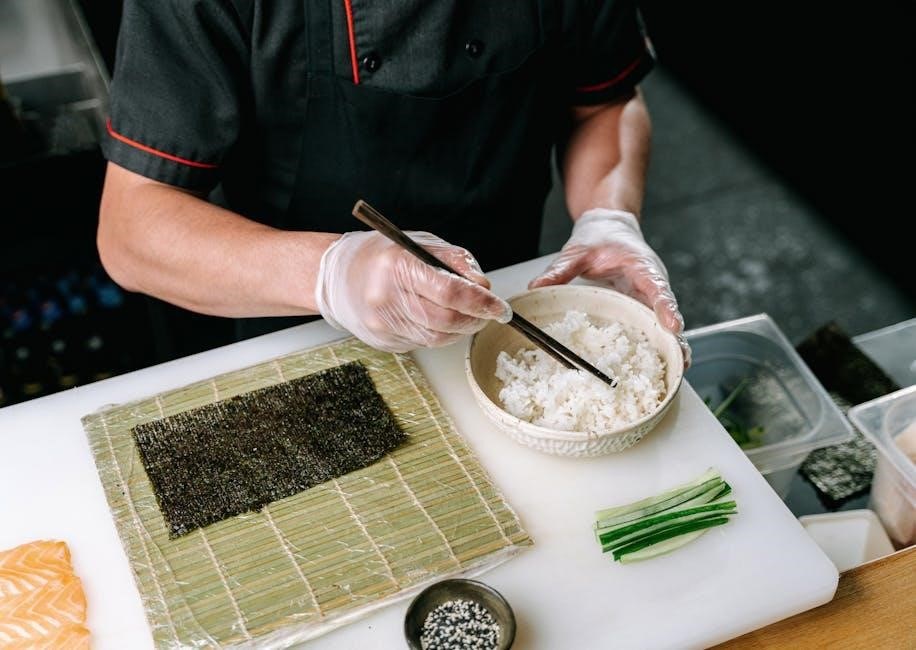
Tips for Perfect Calrose Rice
Achieve perfect Calrose rice by adjusting water ratios, incorporating aromatics, and maintaining your rice cooker․ These simple tips ensure fluffy, flavorful results every time․
Adjusting Water Ratio for Desired Consistency
The water ratio is crucial for perfect Calrose rice․ Use 1․2 to 1․3 cups of water per 1 cup of rice for optimal texture․ For firmer grains, reduce water slightly; for softer rice, increase it․ Grace Elkus recommends this balance to avoid gummy or dry results․ Adjusting the ratio ensures fluffy, separate grains or creamier rice, depending on your preference․ A rice cooker simplifies this process, automatically managing the water level for consistent results․ Experiment to find your ideal consistency, but avoid overfilling, as it can lead to mushy texture․
Incorporating Aromatics and Spices
Aromatics like garlic, onions, and ginger add depth to Calrose rice․ Saute them before adding rice for enhanced flavor․ Spices such as turmeric, cumin, or paprika can be mixed in for a vibrant twist․ Grace Elkus suggests using a rice cooker to infuse these flavors evenly․ Simply layer aromatics at the bottom or mix spices with water for a fragrant result․ This method ensures a flavorful dish without constant stirring, making it ideal for home cooks seeking to elevate their meals effortlessly․
Maintaining the Rice Cooker for Consistent Results
Regular cleaning and descaling are essential for optimal rice cooker performance․ After each use, rinse the inner pot and lid with warm water to remove residue․ For tougher stains, mix water and vinegar, then let it soak․ Grace Elkus recommends descaling every few months to prevent mineral buildup․ Always dry the cooker thoroughly to avoid rust․ Check the power cord and heating element for damage․ Proper maintenance ensures consistent results and extends the cooker’s lifespan, making it a reliable tool for perfect Calrose rice every time․
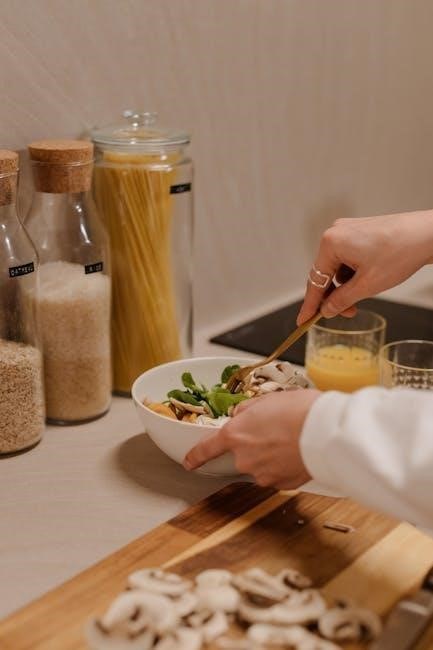
Common Mistakes to Avoid
Overfilling the rice cooker, not allowing rice to rest, and using incorrect water temperature are common errors․ These mistakes can lead to uneven cooking or mushy texture;
Overfilling the Rice Cooker
Overfilling the rice cooker is a common mistake that can lead to uneven cooking and messy cleanup․ Calrose rice expands during cooking, so leaving adequate space is crucial․ Using the correct water ratio (typically 1:1․2 for Calrose rice) ensures the rice cooks evenly without overflowing․ Grace Elkus, a culinary expert, emphasizes the importance of proper measurement to achieve fluffy, tender grains․ Always use the provided measuring cup and avoid exceeding the cooker’s capacity for optimal results and to prevent sticky or mushy texture issues․
Not Allowing the Rice to Rest
Not allowing Calrose rice to rest after cooking can result in a less-than-desirable texture․ Once the cooking cycle completes, letting the rice sit for 5-10 minutes ensures steam is evenly distributed, preventing clumping․ This step is crucial for achieving fluffy, separate grains․ Grace Elkus, a culinary expert, stresses that rushing to fluff the rice can lead to a soggy or uneven texture․ Allowing it to rest guarantees a perfect finish, making the extra few minutes well worth the wait for optimal results in your rice cooker․

Using Incorrect Water Temperature
Using incorrect water temperature can significantly affect the quality of cooked Calrose rice․ Cold water may result in undercooked or uneven grains, while hot water can cause the rice to cook too quickly, leading to mushiness․ Grace Elkus, a culinary expert, emphasizes the importance of using room-temperature water for consistent results․ Rice cookers are designed to regulate temperature, but starting with the right water temperature ensures optimal cooking․ Always use fresh, cool water to achieve fluffy, perfectly cooked Calrose rice every time․
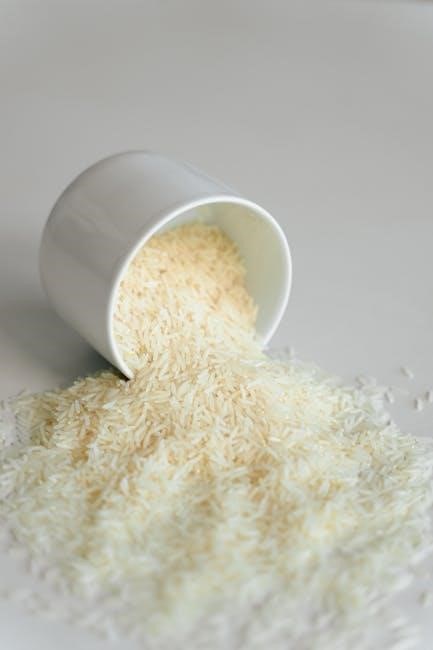
Troubleshooting
Cooking Calrose rice can sometimes result in undercooked or overcooked grains․ Adjusting water levels or cooking time often resolves these issues, ensuring perfectly cooked rice every time․
Fixing Undercooked or Overcooked Rice
If Calrose rice is undercooked, add a splash of water, cover, and let it steam for a few more minutes․ For overcooked rice, fluff gently to separate grains․ Grace Elkus suggests adjusting water ratios to prevent these issues․ Always allow the rice to rest after cooking to ensure even texture․ Monitoring the rice cooker’s progress can help achieve perfectly cooked grains every time, avoiding both undercooked and overcooked results․
Resolving Mushy or Dry Texture Issues
Mushy Calrose rice often results from excess water․ To fix, drain excess water and let it steam with a clean cloth to absorb moisture․ For dry rice, add a splash of water, cover, and steam briefly․ Grace Elkus recommends adjusting water ratios to prevent these issues․ Ensuring the rice cooker is not overfilled and using the correct water ratio helps achieve the perfect texture․ Proper fluffing after cooking also aids in resolving texture problems, ensuring fluffy and separate grains every time․
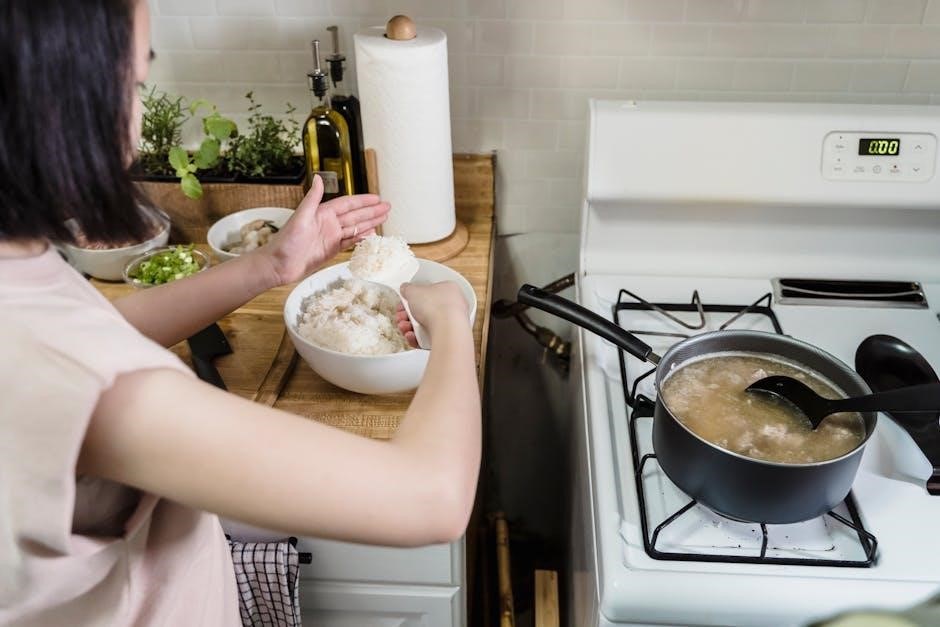
Recipe Ideas Using Cooked Calrose Rice
Cooked Calrose rice is versatile for various dishes․ Popular options include stir-fries, fried rice, curries, casseroles, salads, and sushi rolls․ These recipes showcase its adaptability and flavor retention․
- Stir-fries with vegetables and proteins
- Fried rice with eggs and soy sauce
- Curries and casseroles for hearty meals
- Salads with fresh herbs and dressings
- Sushi rolls for a Japanese-inspired treat
Stir-Fries and Fried Rice Recipes
Cooked Calrose rice is a perfect base for stir-fries and fried rice․ Its medium-grain texture holds up well to stir-frying, absorbing flavors without becoming mushy․ Classic additions include vegetables like carrots, peas, and onions, along with proteins such as chicken, shrimp, or tofu․ Fried rice is elevated with eggs, soy sauce, and sesame oil for a savory, umami-rich dish․ For best results, use day-old rice to ensure it’s dry enough for crispy, separate grains․ Customize with your favorite ingredients for a quick, satisfying meal․
- Vegetable stir-fry with soy sauce and garlic
- Chicken fried rice with scrambled eggs
- Shrimp and vegetable combo
- Tofu and mixed vegetable stir-fry
Curries and Casseroles
Calrose rice pairs perfectly with curries and casseroles, offering a creamy, clingy texture that absorbs flavors beautifully․ In curries, it complements spices like turmeric, cumin, and coriander, while in casseroles, it blends seamlessly with vegetables, meats, and cheeses․ The rice cooker ensures the rice is tender and moist, making it an ideal base for hearty, one-pot dishes․ Try pairing it with coconut-based curries or layered casseroles for a satisfying meal․
- Chicken and vegetable curry
- Beef and broccoli casserole
- Vegetable and cheese bake
- Thai-inspired coconut curry
Salads and Sushi Rolls
Calrose rice is a versatile base for salads and sushi rolls, thanks to its clingy texture and mild flavor․ Cooked to perfection in a rice cooker, it holds up well in refreshing salads like Asian-style mixes or grain bowls; For sushi rolls, its stickiness ensures rolls stay intact, making it ideal for classics like California rolls or spicy tuna rolls․ The rice cooker’s consistent results guarantee the right texture for these dishes every time․
- California rolls with crab and avocado
- Spicy tuna rolls
- Asian-style chicken salads
- Vegetable and tofu grain bowls
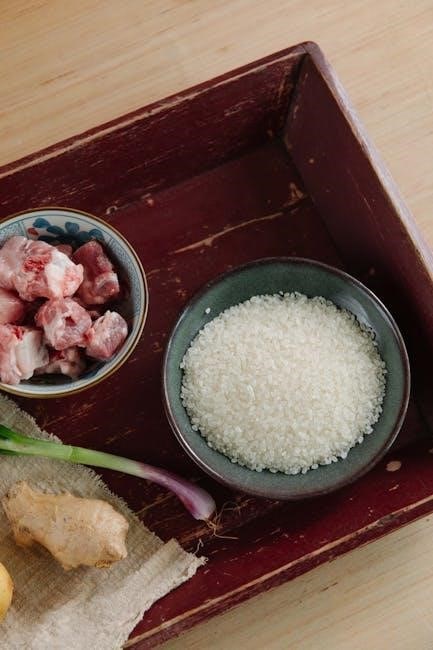
Storage and Reheating
Store cooked Calrose rice in an airtight container in the fridge for up to 5 days or freeze for up to 3 months․ Reheat with a splash of water in the microwave or steamer to restore moisture and texture․
Proper Storage Techniques
Store cooked Calrose rice in an airtight container in the refrigerator to maintain freshness for up to 5 days․ For longer storage, freeze it in a sealed container or freezer bag for up to 3 months․ Ensure the container is moisture-proof to prevent spoilage․ When storing uncooked rice, keep it in a cool, dry place away from direct sunlight․ Use a clean, dry scoop to prevent contamination․ Always check for signs of spoilage before consuming stored rice․ Proper storage helps preserve texture and flavor, ensuring your Calrose rice remains fresh and ready for future meals․
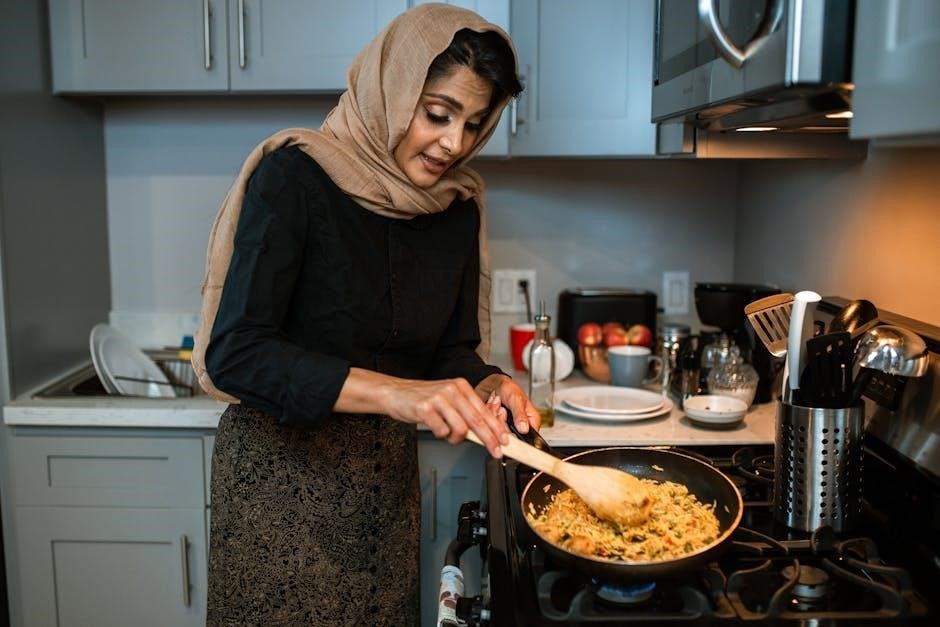
Best Practices for Reheating Cooked Rice
Reheat cooked Calrose rice using a rice cooker, microwave, or stovetop for optimal results; Add a splash of water or broth to prevent dryness․ Microwave on low for 30-45 seconds, stir, and check․ On the stovetop, heat with a lid over low heat, stirring occasionally․ Avoid overcrowding the pot․ For a rice cooker, add water and reheat on the “keep warm” or “reheat” setting․ Fluff the rice with a fork after reheating to restore texture․ Ensure the rice is steaming hot before serving to maintain food safety and freshness․
Cooking Calrose rice with a rice cooker offers ease and consistency, ensuring perfect texture and flavor․ Experiment with recipes to explore its versatility and enjoy delicious meals effortlessly․
Final Thoughts on Cooking Calrose Rice
Cooking Calrose rice with a rice cooker is a simple yet effective method for achieving perfect results․ It ensures fluffy, tender grains with minimal effort, making it ideal for home cooks․ Grace Elkus, a culinary expert, emphasizes the convenience and reliability of this hands-off approach, which is especially useful for those looking to save time and money․ By following basic guidelines and avoiding common mistakes, anyone can master the art of cooking Calrose rice․ Experiment with seasonings and recipes to unlock its full culinary potential and enjoy delicious meals effortlessly․
Encouragement to Experiment and Explore
Don’t be afraid to experiment with Calrose rice! Its versatility makes it a perfect canvas for creativity․ Try adding aromatics like garlic or ginger, or mix in spices for unique flavor profiles․ Grace Elkus suggests that the hands-off nature of rice cookers makes it easy to explore new recipes without stress․ Whether you’re making stir-fries, curries, or sushi, Calrose rice adapts beautifully․ Embrace the freedom to innovate and discover the endless possibilities this rice offers․ Your culinary journey with Calrose rice is just beginning!
